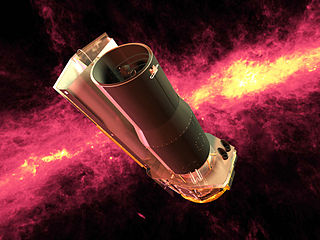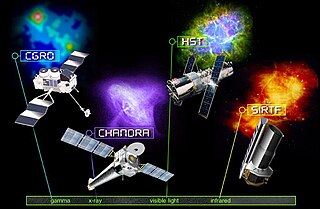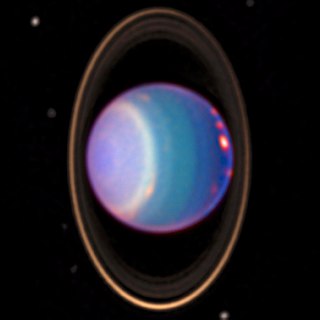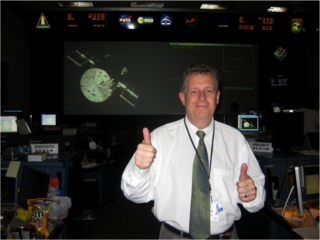
A space telescope or space observatory is an instrument located in outer space to observe distant planets, galaxies and other astronomical objects. Space telescopes avoid the filtering of ultraviolet frequencies, X-rays and gamma rays; the distortion (scintillation) of electromagnetic radiation; as well as light pollution which ground-based observatories encounter.

The Spitzer Space Telescope (SST), formerly the Space Infrared Telescope Facility (SIRTF), is an infrared space telescope. It was launched in 2003 and is planned to be retired in January 2020.

The James Webb Space Telescope is a space telescope that is planned to be the successor to the Hubble Space Telescope. The JWST will provide greatly improved resolution and sensitivity over the Hubble, and will enable a broad range of investigations across the fields of astronomy and cosmology, including observing some of the most distant events and objects in the universe, such as the formation of the first galaxies. Other goals include understanding the formation of stars and planets, and direct imaging of exoplanets and novas.
Ball Aerospace & Technologies Corp. is an American manufacturer of spacecraft, components, and instruments for national defense, civil space and commercial space applications. The company is a wholly owned subsidiary of Ball Corporation, with primary offices in Boulder and facilities in Broomfield and Westminster in Colorado, with smaller offices in New Mexico, Ohio, Northern Virginia, Missouri, and Maryland.

NASA's series of Great Observatories satellites are four large, powerful space-based astronomical telescopes launched between 1990 and 2003. They were built with different technology to examine specific wavelength/energy regions of the electromagnetic spectrum: gamma rays, X-rays, visible and ultraviolet light, and infrared light. Three remain operational as of 2019.

The Near Infrared Camera and Multi-Object Spectrometer (NICMOS) is a scientific instrument for infrared astronomy, installed on the Hubble Space Telescope (HST), operating from 1997 to 1999, and from 2002 to 2008. Images produced by NICMOS contain data from the near-infrared part of the light spectrum.

A coronagraph is a telescopic attachment designed to block out the direct light from a star so that nearby objects – which otherwise would be hidden in the star's bright glare – can be resolved. Most coronagraphs are intended to view the corona of the Sun, but a new class of conceptually similar instruments are being used to find extrasolar planets and circumstellar disks around nearby stars as well as host galaxies in quasars and other similar objects with active galactic nuclei (AGN).
Marc Postman is an American astronomer at the Space Telescope Science Institute in Baltimore, Maryland, United States. His research interests include observational studies of the formation and evolution of galaxies and large scale structure in the universe. His work focuses on determining, observationally, the relationships between galaxy-scale phenomena and the surrounding large-scale environment and matter distribution.
Telescope for Habitable Exoplanets and Interstellar/Intergalactic Astronomy (THEIA) is a NASA-proposed 4-metre optical/ultraviolet space telescope that would succeed the Hubble Space Telescope and complement the infrared-James Webb Space Telescope. THEIA would use a 40-metre occulter to block starlight so as to directly image exoplanets.

The Wide Field Infrared Survey Telescope (WFIRST) is a NASA infrared space observatory currently under development. WFIRST was recommended in 2010 by United States National Research Council Decadal Survey committee as the top priority for the next decade of astronomy. On February 17, 2016, WFIRST was approved for development and launch.

The NASA Exoplanet Science Institute (NExScI) is part of the Infrared Processing and Analysis Center (IPAC) and is on the campus of the California Institute of Technology (Caltech) in Pasadena, CA. NExScI was formerly known as the Michelson Science Center and before that as the Interferometry Science Center. It was renamed NExScI in the Fall of 2008 to reflect NASA's growing interest in the search for planets outside of our solar system, also known as exoplanets. The executive director of NExScI is Charles A. Beichman.
Astrophysics Strategic Mission Concept Studies [AMSCS] is an program within the National Aeronautics and Space Administration agency of the United States government for possible projects leading to probable prospective missions.

The 2012 National Reconnaissance Office space telescope donation to NASA was the declassification and donation to NASA of two identical space telescopes by the United States National Reconnaissance Office. The donation has been described by scientists as a substantial improvement over NASA's current Hubble Space Telescope. Although the telescopes themselves are being given to NASA at no cost, the space agency must still pay for the cost of instruments and electronics for the telescopes, as well as the launch of the telescopes. On February 17, 2016, the Wide Field Infrared Survey Telescope (WFIRST) was formally designated as a mission by NASA, predicated on using one of the space telescopes.

SAFIR is a proposed space observatory for far-infrared light. The plan calls for a single large mirror 5–10 meters (16–33 ft) in diameter, cryogenically cooled to 5 kelvins. This would feed detector arrays sensitive from 5 to 1000 µm. The possibility of servicing such a telescope in space has been evaluated.

Charles Mattias ("Matt") Mountain is currently the President of the Association of Universities for Research in Astronomy which designs, builds, and operates telescopes and observatories for the National Science Foundation (NSF) and the National Aeronautics and Space Administration (NASA). AURA's NASA center is the Space Telescope Science Institute (STScI), responsible for the science mission for the Hubble Space Telescope, the science and operations for the James Webb Space Telescope, and the MAST data archive. AURA’s NSF centers are Gemini Observatory, the National Optical Astronomy Observatory (NOAO), and the National Solar Observatory (NSO). Dr. Mountain and AURA are also responsible for the NSF construction projects: the Daniel K. Inouye Solar Telescope (DKIST) on Haleakalā, Hawaii and the Large Synoptic Survey Telescope (LSST) on Cerro Pachón in Chile.
The Habitable Exoplanet Imaging Mission (HabEx) is a space telescope concept that would be optimized to search for and image Earth-size habitable exoplanets in the habitable zones of their stars, where liquid water can exist. HabEx would aim to understand how common terrestrial worlds beyond the Solar System may be and the range of their characteristics. It would be an optical, UV and infrared telescope that would also use spectrographs to study planetary atmospheres and eclipse starlight with either an internal coronagraph or an external starshade.
Origins Space Telescope (OST) is a concept study for the Far-Infrared Surveyor space telescope mission. Still a preliminary concept in formulation, it will be presented to the United States Decadal Survey in 2019 for a possible selection to NASA's Flagship Program. The OST would provide an array of new tools for studying star formation and the energetics and physical state of the interstellar medium within the Milky Way using infrared radiation and new spectroscopic capabilities.

The Lynx X-ray Observatory is a concept study for the next X-ray space telescope mission. Still a preliminary concept in formulation, it will be presented to the United States Decadal Survey in 2019 for a possible selection to NASA's Large Strategic Science Missions. If funded and developed, Lynx will be able to detect and characterize extremely faint objects and study physical processes in a very wide range of astrophysical settings.
Nautilus Deep Space Observatory (NDSO) is a proposed deep space fleet of space telescopes designed to search for biosignatures of life in the atmospheres of exoplanets.
















